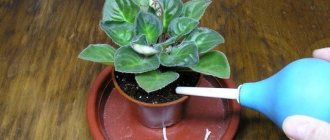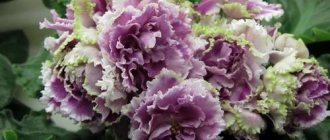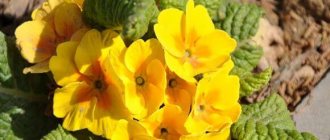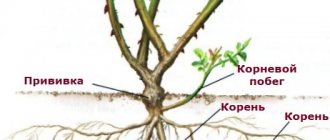History of creation, decoding of the abbreviation “LE”
It was bred in Ukraine by the famous breeder E. Lebetskaya.
All varieties have the prefix LE in their name.
A distinctive feature of the Saintpaulias grown by Elena is the presence of an even, symmetrical rosette.
This variety of violet looks impressive thanks to its rose-like flowers.
Types of stock roses and their features
There are more than sixty species of these beautiful plants. Mainly, such diversity was achieved by breeding scientists who actively worked on developing new varieties of these beautiful flowers so that they could please you with their presence in your garden. We will focus only on the main types that you can distinguish yourself when you see them in a store or on the market.
Common mallow
This is a perennial plant that blooms in pink, red, crimson, burgundy, yellow, and black. The only color that is not typical of mallow is blue. This flower is unpretentious in its life activity, but it also does not grow in too harsh conditions. Ordinary varieties look simple, but at the same time create a certain homely atmosphere in the front garden. They remind you of quiet village evenings.
Terry
Scientists have developed many varieties of terry mallows. Their petals are so thick that they make the bud look like crown peonies. It all looks very beautiful, unusual and, to some extent, gentle. These varieties are expensive, but it's worth it.
Semi-double variety
Such flowers are a cross between a regular and a double variety. The bud consists of inner petals, which create a sort of ball, and outer petals, which are wavy. These varieties are also artificially bred and can come in a wide variety of colors, even the most variegated ones.
Stock roses grow from 60 centimeters to 2.5 meters. The largest varieties are often used as part of a hedge. The shorter ones are suitable for planting in neat small flower beds.
Photo and description of the variety
The petals are white or pinkish, sometimes with crimson splashes, with a corrugated wavy border.
The flowers themselves are not large (4-5 cm), but form a lush “cap”.
The peduncle produces a large number of flowers, the first of which are large and massive, the lower ones are smaller.
The compass rose has large and wavy leaves that are dark green in color.
Useful properties of violets
Indoor violet can not only please the eye of the gardener, but also help with various diseases. It has a beneficial effect on the body during kidney inflammation, bronchitis, joint pain and atherosclerosis . A decoction is prepared from a Saintpaulia leaf poured with boiling water and added to tea. Take it within 24 hours. You can bathe children in violet decoction. This method will help cure scrofula, rickets, eczema and skin rashes. Violet tinctures help with tinnitus after childbirth. With the help of a violet leaf you can get rid of insomnia and neuroses.
The plant contains toxic substances that, if used incorrectly, poison the body . Between courses there is a break of a month.
It is difficult to select the best varieties of Saintpaulia given the huge variety. The most beautiful, of course, are the collection varieties . The most popular among gardeners are Winter Parasol, Adonis, Rococo Pink and many others.
People often confuse violets with another crop - Saintpaulia. There are similarities between them, but still these are two different plants, which have their own characteristics not only in appearance, but also in content.
Characteristics. Saintpaulia “sport”
A distinctive feature of this variety is its ability to go into sports.
Sport is the difference between Saintpaulia and the mother plant (variety). The new plant has no varietal characteristics or they are barely noticeable.
It happens that the shape and color of the leaf is the same for both the variety and the sport. To see the difference you need to wait until flowering.
Often sports produce bright red or plain pink flowers, which also look impressive. When changing the sheet, the first thing that disappears is the waviness of the sheet.
If you collect varietal violets, pay attention to other spectacular varieties: “Raisin”, “Chimera”, “Dance of Galaxies” and “Frosty Cherry”.
Sports violets Wind rose
The Windrose violet is considered a rather controversial crop, since this plant combines a high level of decorative characteristics, compared to other subspecies, and a rather difficult task in preserving morphological characteristics. Many gardeners believe that with proper cultivation and high-quality propagation, a crop can retain its varietal characteristics for quite a long time, although this does not always work out for fairly experienced gardeners. Often this plant begins to sport, which means changing its appearance relative to the standard crop. The most common sport of the Violet variety Windrose is considered to be a change in the color of the flower’s petals, when the pink tint changes to snow-white or rich scarlet. The sport of violets Windrose can sometimes be found. At this time, the leaves may lose their wavy structure and become completely straight. The color of the foliage may also change, for example, from a rich green tint they acquire a light yellow color. As a result, most gardeners who were unable to preserve varietal characteristics grow plants with an intense crimson or dark pink color in their homes, and they do not intend to give up breeding such specimens. There are cases when the same rosette contains flowers with completely different shades of petals. Although this fact only increases the decorative characteristics of this plant, and thereby makes this crop even more unusual.
Growing rules
The wind rose, like many other violets, loves light and warmth. In order for the plant to please you with flowers and not cause a lot of trouble, you need to comply with some care conditions.
Priming
Like any violets, Windrose prefers light, airy and permeable soil. You can buy it at a specialty store or mix it yourself.
The variety requires constant replanting due to increased sensitivity to acidic soil.
Ground eggshells or chalk will help reduce soil acidity. When mixing soil at home, sterilize all components.
Site selection and temperature
Wind rose, like other violets, does not tolerate direct sunlight, drafts and temperature changes.
Optimal temperature for growing +18 +25.
Humidity is also the main component when growing Saintpaulia and is in the range of 40-50%.
To form a neat rosette, the pot should be periodically turned towards the light.
Choosing a pot
Sometimes the leaves of the Compass Rose produce a large, slightly spreading rosette. To prevent this from happening, choose a pot for planting with a diameter half the size of the rosette.
Due to the proximity of the roots to the surface, the pots should not be deep.
Watering
Several indicators should be taken into account
- How do you water violets?
- Season. In summer, water 1-2 times a week, in winter as it dries out.
- Age and growth of the plant.
- Pot size.
- Soil composition.
- Ambient temperature.
From top to pallet
Violets can be watered either in the tray or from above.
When watering an earthen clod, it is important not to get water on the leaves of the plant.
If you want to reduce the volume of the outlet, do not use the wick method when watering.
However, this method is indispensable in case of long-term absence and sometimes it is necessary to use it.
How to water
In terms of lighting, the Wind Rose is a rather whimsical plant. The same applies to watering. The soil in the pot with this violet should be moistened correctly. Water the Wind Rose by placing the container in which it grows on a tray. The water is pre-settled for 24 hours. Pour it into a watering can with a narrow spout. When watering, water should not be allowed to fall on the violet leaves. It is quite difficult to do this when using, for example, an ordinary glass, even despite the relative looseness of the Wind Rose rosette.
Very often, the soil under the Windrose violet is also moistened using the wick method. This technology is not used for plants with spreading rosettes. However, in the Wind Rose this trait is a varietal one. The growth of its leaves does not depend on the watering method used. Therefore, it is permissible to use wick technology for it. This technique consists of the following:
- The wick is made from any synthetic material. This could be, for example, a rope or a twisted scrap of old stockings. The thickness of the finished wick should be approximately 0.15-0.2 cm.
- One end of the manufactured wick is passed through the drainage hole of the pot under the violet and secured securely with a loop.
- The free end of the wick is lowered into some container with water. This could be, for example, a piece of plastic bottle or glass. The pot with the violet itself and the wick is placed above it.
With this method of watering, the plant will be provided with the amount of moisture it needs for about 2 weeks.
Reproduction
Violets are bred in several ways
| Reproduction method | Process |
| Rooting cuttings in water |
|
| Rooting cuttings in the ground |
|
| Rooting with leaf fragments |
|
| Rooting by stepson |
|
| Rooting with a peduncle |
|
| Children |
|
| Seeds |
|
Before cutting All tools are processed. When propagated by cuttings, the leaves must be healthy and without damage.
Many varietal violets can be easily propagated by leaves. For example, the “Wedding Bouquet” variety.
Plant care
Violet Windrose is extremely demanding on the level of soil moisture and the presence in it of all the nutrients necessary for development. Therefore, proper organization of watering and fertilizing are the main measures for caring for the plant.
Watering rules
Watering violets is carried out strictly at the root, evenly moistening the soil. Only soft water is used for irrigation: tap water, melt water or filtered spring water, standing for 1-2 days.
Experienced flower growers advise using wick watering of violets for this variety, when the plant independently regulates the level of soil moisture. Such watering is organized using a wick made of rope 0.15-0.20 centimeters thick. One end of the rope is placed in the soil of the flower pot, and the second is released through the drainage hole and placed in a container of water over which the pot is placed. Water enters the soil through the wick in the volume required by the plant’s root system.
[adsp-pro-5]
Wick watering completely eliminates the risk of waterlogging or drying out the soil, which is very harmful for the Windrose violet.
Organization of fertilizing
To feed the Windrose violet, mineral fertilizers intended for flowering indoor plants are used. The ideal option is to use special fertilizers for violets.
Violets of the Wind Rose variety require periodic feeding.
The feeding regime depends on the time of year:
- in spring and summer – once every 10-14 days;
- in autumn - once every 30 days;
- In winter, fertilizing is not carried out.
During the period of active growth, violets need nitrogen fertilizers to promote leaf growth. During the set of buds, the nitrogen content in fertilizing is reduced to a minimum, and during flowering it is completely eliminated. A flowering plant needs phosphorus and potassium.
Important. You cannot feed violets for 15 days after transplantation, or during illness.
Transfer rules
Violet Windrose is demanding on soil nutrition, so it needs regular replanting. It is impossible to keep a flower in one soil for a long time, even with frequent feeding, since the soil is depleted and cannot provide the root system with the necessary nutrition. In addition, the old soil becomes acidic, which can destroy the violet, since its roots cannot tolerate acid.
The violet transplant schedule depends on the age of the plant:
- 1-2 years – twice a year, in spring and autumn;
- From 3 years – once a year in the spring.
Violets should not be planted in a pot that is too large.
Unscheduled transplants are necessary when a whitish coating appears on the soil surface and in case of rotting of the root system. It is also necessary to replant the violet if children have formed around the mother rosette. This often happens if the violet is planted in a pot that is too large or if it is over-fed with nitrogen fertilizers. Children must be removed. For a violet to bloom, only one rosette must grow in a pot .
Indoor violets are transplanted using the transshipment method. A new pot for the plant is selected 2-3 centimeters larger than the previous one. The soil for growing violets can be purchased specially prepared or prepared independently from leaf and turf soil, peat, sand and humus. For looseness, vermiculite or sphagnum moss is added to the mixture.
When replanting, you need to carefully examine the roots of the plant. Healthy roots are white, without spots or rotten areas. If the roots are yellowish or brown, it means they are affected by gilly or fungus. Such roots need to be cut off, otherwise they will cause the entire root system of the violet to rot and the plant will soon die.
[adsp-pro-6]
During transplantation, violets from the third year of life must be rejuvenated by removing part of the roots and tearing off the lower leaves. After removing the leaves, the stem is buried down to the second row of leaves. After this procedure, new, young roots will begin to grow on the bare stem.
Pruning and shaping the bush
If you want to see a beautiful violet bush, then sometimes the leaves need to be trimmed.
The compass rose has a rather large rosette; the lower leaves are periodically removed, resulting in the trunk being “bare.”
It doesn't look nice.
It can be replanted by deepening the bare stem.
Or cut the violet and root it.
The resulting children need to be removed, they slow down flowering. If you decide to propagate your violet, the children are removed when they reach 4-5 cm.
Basic conditions for growing violets at home
Violet lovers will confirm: the microclimate for Saintpaulia is one of the main components of successful flowering. This statement also applies to the Malachite Rose violet. When growing it, consider three factors: lighting, temperature and humidity.
Placement and lighting
Optimal lighting is bright, diffused light. A window sill near a west or east window is ideal. If the light is very bright, you can cover the window with a light cloth or paper.
Daylight hours should be up to 14 hours. To extend it in winter, you can use biolamps.
Temperature and humidity
Violet needs a temperature of +18. +24°C. It is not advisable to lower it lower. +15°C is already dangerous indicators. Avoid drafts and sudden temperature changes.
Keep humidity at 50-60% or higher. Malachite rose will be damaged by dry air. Direct moistening from a spray bottle is also unacceptable. If the humidity level is below normal, use a humidifier.
What determines the color of flowers
In addition to frequent sports activities, it is capable of darkening the flower. Your pale pink pet may turn deep pink or even red.
There are several reasons:
- Age.
- Temperature change. The increase affects the color change of the petals. The decrease affects the increase in the green ruffle of the leaf.
- Increasing soil acidity.
The ancestors of modern violets were predominantly purple in color. Therefore, when color changes under the influence of temperatures or when going to sports, the flowers darken.
How to grow a violet from a leaf? Features of caring for Saintpaulia “Royal Lace” and “Ice Rose”.
Plant diseases and pests
Violet is affected by diseases if the maintenance recommendations are not followed and the rules of caring for the plant are not followed.
Most often, violets suffer from the following diseases:
- If the leaves of the violet begin to turn yellow, it should be treated with a fungicide.
Powdery mildew. Signs of the disease are whitish spots on the leaves. Fundazol is used for treatment.
- Late blight. Appears as brown spots on the foliage. Leads to root rot. If the damage is severe, the plant cannot be cured.
- Gray rot. A sign of the disease is gray or brownish spots on the leaves. For treatment, violets are treated with a fungicide.
- Rust. The disease manifests itself as brownish-orange spots on the leaves. To combat it, use a weak solution of copper sulfate.
In addition to diseases, insect pests can cause harm to violets:
- Ticks. When they appear, the leaves become covered with cobwebs.
- Scale insects. The leaves become covered with a sticky coating and brown spots.
- Thrips. All parts of the plant are affected. Small yellow spots appear on the leaves, flowers become covered with black dots and become deformed.
At the first signs of pests, the violet must be washed with soapy water and sprayed with an insecticide (Aktara, Alatar, Aktellik, etc.)
Attention. Inexperienced flower growers often encounter the problem that violets die in the third year of life. If before this the leaves begin to curl and become hairy, it means that the plant has been infected by the cyclamen mite. For prevention, violets must be treated with an insecticide every six months.
How to preserve varietal violets
To ensure that your violet does not change in appearance after purchase and retains all varietal characteristics, follow simple rules
- Have you already tried propagating varietal violets?
- Try to maintain a constant temperature.
- Do not expose the plant to stress.
- Provide timely and quality care.
Not really
It is believed that violets that have simple colors are less prone to change.
Before purchasing “Wind Rose,” which makes you fall in love at first sight, study in detail the pros and cons of the variety.
Expert opinion
Pavlova Ekaterina Mikhailovna – agronomist, landscape designer
Participant of scientific conferences
When buying a scion or baby, be prepared to receive a plant that will be completely different from the mother one.
Also, do not forget that the Wind Rose has a large rosette. And if you admire flowers 2-3 times a year, then the rosette will be constantly before your eyes.
If Saintpaulias do not bloom at all, read the material at the link. It will be relevant for owners of most varietal Saintpaulias, for example, “Duchess” violets.
Therefore, when choosing flowers, first of all pay attention to the leaves.
How to propagate at home
To preserve varietal characteristics, propagation is best carried out by separating daughter rosettes.
This is usually done when replanting a plant in spring or autumn:
- The blade separates the daughter rosette.
- The sprout is planted in a peat briquette.
- A month later, when the bush is well rooted, it is transplanted into a pot.
Another method is propagation by leaves, which is traditional for violets. As mentioned above, this method is undesirable for the Wind Rose, as this often leads to a loss in the quality of the flowers. If the grower nevertheless decides to propagate violets using this method, you need to select the strongest leaves from the second tier above the soil - they are cut with a blade at an angle of 45° and placed in peat, a soft non-acidic substrate, or simply in settled water. After 30–45 days, the plant will be ready to plant in a pot.
Popular varieties
Green violets come in a wide variety of species. It is worth noting the most common varieties.
This variety is distinguished by rather large double flowers, which are distinguished by their bright cherry color with a wide green border running along the very edge. When the violet is in a cooler place, the border spreads over almost the entire flower. Then it turns green with a small cherry “bald spot” in the very middle. This makes the violet more sophisticated and beautiful.
"LE-Green Rose"
https://www.youtube.com/watch?v=ytaboutru
These are beautiful semi-double flowers that resemble pansies. They have a soft pink color. The edges are framed with green fringe. The leaves of this plant are slightly waxy; in addition, they have a wavy shape. The only drawback of such a violet is the rapid withering of flowers.
"N-Green tea"
This violet is distinguished by its unusual beauty. It is a large bouquet consisting of semi-double flowers. Their color is striking with its delicate white-green hue. In some cases, a pinkish color is visible at the very edges of the petals. This violet blooms for a long time. Green tea leaves are heart-shaped and dark green in color.
The violet with this name has fairly large double flowers with a dark purple hue. Its edges are framed by a wide green border. Each petal is slightly curled at the very edge, and it resembles a knot. The border is especially visible in cooler places. Flowering continues for a long time due to the fact that each flower opens slowly. The leaves of this Saintpaulia are standard. She will not require special care.
"RS-Green Lagoon"
This Saintpaulia has a completely unusual color. Its outer petals have a soft green tint, but white is considered the main color. In addition, almost every petal has small blue streaks. The shape of the flowers is a bit like cabbage forks. Many people note that over time the color of the flower becomes darker.
Green dragon
This variety of violets is distinguished by the fact that it can have both double and semi-double flowers, characterized by a white tint. At the very edge there is a small bright green border. However, the plant does not bloom for long; in addition, it requires a lot of light. Otherwise, it begins to fade.
Ness pixie grin
This variety of violets was bred by foreign breeders. It is distinguished by large double flowers, similar to pansies. They have a coral coloration with a green cream rosette.
"KO-Young-Green"
This variety was bred by the domestic breeder Kosobokov. The flower attracts with its soft white double flowers, the edges of which are framed by a thick green border. Some petals may have blue fragments. The leaves are medium and have a rounded shape.
"EK-Green Cockatoo"
This plant looks a little like a flock of green parrots, which are located on shiny green leaves. The double flowers of this plant have an oblong shape and are associated with pansies. The petals are light green and have a bright green border.
Saintpaulia of this variety has large double white flowers that resemble pompoms. The edges have a bright green border. In some flowers, pink inclusions can be seen in the very middle.
This variety is distinguished by rather large double flowers that are white in color. In some cases, it may also have a pinkish tint. The edges of the petals have a wide corrugated green border. The green leaves are also corrugated, with a silvery tint.
Green horizon
This variety of violets was bred by foreign breeders. The flower itself is distinguished by white double petals with very wide green edges. When it opens, its color is completely white, however, after a while it turns almost completely green. In addition, the longer the violet grows, the larger the flowers themselves become. The flowering itself can last a long time. Violet leaves are large.
This violet has large flowers with a delicate salad shade. They are framed by a wide fringed border and have slightly jagged edges. Its leaves are wavy, with bright green fringe along the edges.
Louisiana green
https://www.youtube.com/watch?v=ytpolicyandsafetyru
In addition to the above varieties of violets, there are many more not so popular, for example, “BO-Green Turtle”.
When and how does it bloom
If you care for the plant correctly, buds will appear regularly as the old flower stalks wither. If there is no goal to obtain seeds, then the wilted flowers along with the stems are carefully removed immediately after wilting.
Types of flowers
Violets can have corollas with divided or fused petals, the edges of which are smooth, jagged, or terry. The color is monochromatic, multi-colored, with specks, and a contrasting border.
Flower shapes
Hybrids with flowers resembling rosebuds are very popular. In addition, there are other forms:
- bell;
- cup-shaped (bowl);
- “wasp” - with protruding long tips (wasp);
- “pansy” (pansy);
- "star" (star);
- scallop;
- terry and semi-double;
- simple (5 fused petals).
Flowering period
On average, homemade Saintpaulias bloom 8 months a year. The period may vary, depending on the variety, lighting, and age of the plant. More often it covers the warm season, but nothing prevents the violet from blooming in winter if all the necessary conditions are created for it.
Compared to many other flowering indoor plants, Saintpaulia Winter Rose is very unpretentious. The opportunity to admire its unusually large and bright flowers all year round pays off the collector’s efforts to find it in stores, where this beautiful variety can be found more and more often.
Top 10 most popular varietal Saintpaulias
Meet the popular and very pretty varieties of violets that can decorate your home.
EK Blue-Eyed Russia
The author of this attractive Saintpaulia, which won prizes at exhibitions in the USA and Russia, is Elena Korshunova.
The variety does not require special care, loves cool weather, and reproduces well.
Flowers are large stars (5-7 cm), semi-double, double, pale blue. They form a beautiful hat. The petals are elongated, slightly wavy. There is a purple edging along the edge of the petals.
The leaves are green and pointed. The socket is large, smooth, standard.
Dn-Teen French
This bright, uniquely beautiful Saintpaulia was obtained by Dmitry Denisenko (Ukraine).
The flowers are large purple pansies with a light lilac wide fringe. It blooms luxuriously, brightly, for a long time. The border becomes narrower during the hot period.
The rosette is variegated, smooth, compact, standard.
Disadvantage - it happens that the flower stalks cannot withstand the weight of the flowers and lie on the rosettes.
RS-Aquamarine
This beauty is from the collection of breeder Svetlana Repkina. The variety does not require special care, blooms almost all the time, and blooms slowly.
The flowers are large. Up to 5.5 cm. Color – white with blue streaks. The outside of the petals are green. Each flower has its own special shades.
The leaves are medium green in color. The socket is smooth, neat, standard.
RS-Georgette
The author of the variety is Svetlana Repkina.
The flowers attract with an intense dark purple and lilac color. In size - large, in shape - curly, forming a hat. Blooms profusely and for a long time.
The leaves are dark green, large, wavy, hard. The socket is standard.
Do not be upset if the petals turn out to be straight at the first flowering. This is a feature of the variety. Ruffles will appear later.
EK-Gray Ocean
Saintpaulia by Elena Korshunova. Is a sport from EK-Black Pearl. Gives out a lot of stepchildren.
The flowers are very large (up to 5-6 cm), in the form of densely double white and blue balls. Blooms for a long time. The buds may differ in shades.
The leaves are light green, the rosette is standard and large.
Disadvantage: over time, the color of the plant becomes darker and does not convey varietal characteristics well.
Jan Minuet
The author of the masterpiece is Puminova Natalya Aleksandrovna.
The variety does not require special attention, grows easily, and is not greedy for children. Loves water and light. Prefers a window sill rather than a shelving unit.
The flowers are large stars, light pink with a crimson border. They create the impression of airy lightness. They form a beautiful hat. It blooms almost all year round, with a short break for rest.
The leaves are green, pointed. When there is insufficient lighting, the socket rises upward.
Bridal bouquet
Violet creation by Konstantin Morev. Easy to grow and easy to care for.
The flowers are large, double stars, consisting of several layers of corrugated petals. The color is perfect white. The petals on the reverse side are shaded with a silver-ash color. At low temperatures, a greenish border may be present around the edges. Blooms profusely, in the form of a bouquet.
The rosette of the Wedding Bouquet variety is small. Standard.
RS-Ice Rose
Saintpaulia hybrid was bred by breeder Svetlana Repkina. The plant grows quickly, reproduces easily, and is not capricious.
The flowers are semi-double, double, on a white background - cherry strokes, along the edge - a salad-colored fringe. The petals change color. At a temperature not exceeding 20 ° C they lighten to almost white. At 26 °C they become intensely cherry in the middle and white at the base and along the edges. Blooms for a long time.
The leaves are medium green, long, about 13 cm, the rosette itself has a diameter of up to 45 cm. The rosette is smooth and standard.
Green moss
Saintpaulia by breeder Svetlana Repkina.
Flowers are original heads with a diameter of 4-4.5 cm on long peduncles. Semi-double with lace green fringe. The color is white-green with purple strokes. At elevated temperatures, the greenish color fades.
The leaves are medium green, corrugated, shiny, long, and can turn up. This beauty takes a long time to grow and is reluctant to release babies.
Fairy
Uzambara violet from the collection of Tatiana Dadoyan.
The flowers are very large, double, white-pink in color, on strong peduncles. The edge of the petals is jagged, with fuchsia splashes and a bronze edging. In cooler conditions, color features appear brighter.
The leaves are quilted, large, slightly wavy. Standard socket. The variety is unstable and easily forms sports. Loves light very much.
Reviews from flower growers about the variety and tips for growing plants
Natalia. The Violet Wind Rose bloomed for the first time with almost white flowers. I was even upset. The second year I grew larger flowers with a pink tint. And a year later, the petals became deep pink at the base, pale pink in the middle, and white around the edge. Simply a masterpiece. So whoever purchased a young violet, wait until it accelerates and begins to bloom as expected.
Alyona. Violet Windrose is simply a miracle. The flowers are ruffled, soft pink in the center, white at the edges, and the ruffle is pink again. Each flower is colored differently, a true work of art. For beginners, I advise you to leave all the babies when propagating from leaves, because half will go into sports and will not receive the characteristic coloring of the variety.
Flower growers note that the color of the Wind Rose violet depends on the air temperature.
Ksenia. The variety is so diverse in flower color that each one has its own violet. Only the shape of the flower remains unchanged: the edge is beautifully gathered into ruffles, there are many petals. For those who like a compact outlet, I do not recommend using wick watering. The leaves are scattered very widely, and the flowers are lost against their background.
Nina. The development of this violet depends on the size of the pot. I grew the first one in ten - the leaves turned out to look like burdocks, the whole violet is massive. I don’t like these sizes, so I switched to an 8 cm pot. The violet immediately became compact, the leaves shrank, and the flowers turned out to be a cap. The color of flowers depends on the air temperature. I have one Wind Rose that lives in the kitchen, so the flowers are bright pink, almost without white. It’s cool in my living room, the violet there is pale pink, with a lot of white streaks.
Nastya. From leaves taken from a neighbor, I grew 2 violets. One of the offspring produced a variety with the colors characteristic of the Wind Rose, the other produced a sporty variety, deep pink, even a little purple in color, with a white edging along the edge. But the shape of the flowers of both violets is simply a sight for sore eyes, with ruffled edges, real lush roses.
History of appearance and distribution
Characteristics of the Taifi grape variety, cultivation features and description of yield
Violets are a cute and pleasant flower, so it is not surprising that many biologists have shown interest in them. The year 1989 was marked by the development of Saintpaulia varieties with peduncles of different colors, since before that only flowering with a purple hue was known. Once it was possible to understand how to influence the color scheme, scientists took up the size of violets, experimenting with it and creating varieties with miniature or huge petals. Breeding experiments could not go unnoticed. Soon they grew to a more serious level.
Many lovers of such beautiful plants as violets have noticed in flower shops and on the websites of a representative of the flower world called Optimara violets. They are not a separate type of Saintpaulia, they are simply grown by a company with that name. These flowers are considered the most striking representatives of tropical plants, but, unlike simpler species, they can only bloom once. Optimara Saintpaulias do not like the cold very much; any exposure to it leads to a complete stop of the flowering process, and can also deal a crushing blow to the root system, which should only be kept warm. Despite all their beauty, African fort violets do not grow for long and cannot be planted.
You can buy Optimara violets in the form of a small bouquet, which is often sold in pots. This plant can bloom only once, after which there is no point in caring for it anymore. Saintpaulias from this company grow quickly and all bloom at the same time. The main advantage is the abundance of beautiful symmetrical buds on one violet. Such plants are bred for industrial purposes, so they are easy to transport and do not deteriorate during the journey.
Bright flowers and various shades are the hallmark of Optimara violets, so interest in them remains consistently high. A lot of time has passed since the appearance of this brand, because the official time of its origin is considered to be 1930, when M. Dorrenbach in Germany switched from his business of breeding and growing grain crops to Saintpaulia. The co-owner saw global prospects in such a small and simple flower and was able to achieve his goals. His son, Reinholt, made a major contribution to the development, who helped make the modest family business a huge and world-famous enterprise. The first attempts to create a beautiful flower for sale were few in number, the plantations did not exceed 1 square meter, but thanks to their success, all the plants in the greenhouse were soon replaced by Uzambara Saintpaulia.
The main task of the Optimara company is to develop a large number of varieties, which are constantly being replenished. Already, there are several hundred varieties of these flowers that are posted on the company’s website, often they do not even have their own name. Usually a new violet is assigned a number, but the name of the breeder who bred it is always indicated. The production does not set the task of approving or cultivating any particular variety, even if customers like it. The main rule of Optimara is to have the widest range of products.
Exhibition at the Violet House, Moscow, April 2012
Photo report from the exhibition “Blossoming May”, which took place in the Moscow House of Violets on April 20, 2012, where I was invited by the organizers to judge.
The trip to the exhibition was a SUCCESS! Met with breeders (Natalia Puminova (YAN-), Natalya Berdnikova (mini breeder with the prefix N-), Konstantin Morev, Lena Lebetskaya (LE-), Svetlana Repkina (RS-), Galina Lazarenko (LiK-), Irina Kabanova (Petersburg selection of streptocarpus), Alexey Kuznetsov (mini breeder with the prefix SK-), Tatyana Pugacheva (PT-), Natalya Skornyakova (young breeder from Kursk with the prefix RM-). I had great pleasure talking with Moscow collectors. And of course, I took a lot of photographs , so the photo report will be long (consist of several parts), because I want to show you a lot.











